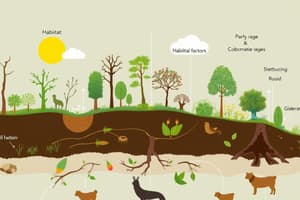Podcast
Questions and Answers
The area where an organism lives including the biotic and abiotic factors that affect it
The area where an organism lives including the biotic and abiotic factors that affect it
- Habitat (correct)
- Niche
- Competition
- Mutualism
Many small organisms live only in a very small part of the larger habitats we humans see
Many small organisms live only in a very small part of the larger habitats we humans see
- Niche
- Resilience
- Microhabitat (correct)
- Parasitism
the ability of an organism to survive and reproduce under circumstances that differ from its optimal conditions
the ability of an organism to survive and reproduce under circumstances that differ from its optimal conditions
- Intraspecific
- Interspecific
- Commensalism
- Tolerance (correct)
Full range of physical and biological conditions in which an organism lives and how the organism uses those conditions
Full range of physical and biological conditions in which an organism lives and how the organism uses those conditions
principle that states that no two species can occupy the same niche in the same habitat at the same time
principle that states that no two species can occupy the same niche in the same habitat at the same time
Competition among members of the same species
Competition among members of the same species
competition among members of different species
competition among members of different species
a symbiotic relationship in which one organism benefits and the other is neither helped nor harmed
a symbiotic relationship in which one organism benefits and the other is neither helped nor harmed
a symbiotic relationship in which one organism lives on or inside another organism and harms it
a symbiotic relationship in which one organism lives on or inside another organism and harms it
symbiotic relationship in which both species benefit from the relationship
symbiotic relationship in which both species benefit from the relationship
series of gradual changes that occur in a community following a disturbance
series of gradual changes that occur in a community following a disturbance
succession that occurs in an area in which no trace of a previous community is present
succession that occurs in an area in which no trace of a previous community is present
first species to populate an area during succession
first species to populate an area during succession
type of succession that occurs in an area that was only partially destroyed by disturbances
type of succession that occurs in an area that was only partially destroyed by disturbances
variety of habitats, communities, and ecological processes in the biosphere
variety of habitats, communities, and ecological processes in the biosphere
the number of different species that make up a particular area
the number of different species that make up a particular area
sum total of all the different forms of genetic information carries by a particular species or by all organisms on earth
sum total of all the different forms of genetic information carries by a particular species or by all organisms on earth
the ability to recover after a disturbance; the ability to deal with change and move on
the ability to recover after a disturbance; the ability to deal with change and move on
Flashcards are hidden until you start studying
Study Notes
Habitat and Niche
- Habitat encompasses biotic (living) and abiotic (non-living) factors that impact an organism's existence.
- Small organisms often inhabit limited areas within broader ecosystems visible to humans.
- Organisms can survive and reproduce in varying conditions, even when those conditions differ from their optimal environment.
- The full range of physical and biological conditions an organism utilizes is termed its ecological niche.
Competition and Symbiosis
- Competitive exclusion principle: No two species can occupy the same niche simultaneously in a shared habitat, leading to resource competition.
- Intraspecific competition occurs among individuals of the same species, while interspecific competition occurs between different species.
- Commensalism is a symbiotic relationship where one organism benefits while the other is not affected.
- Parasitism involves one organism living on or inside another, causing harm to the host.
- Mutualism is a symbiotic relationship from which both species derive benefits.
Ecological Succession
- Ecological succession refers to the gradual changes within a community that follow a disturbance.
- Primary succession occurs in areas devoid of any life or soil remnants from previous communities.
- Pioneer species are the first to colonize an area during the primary succession.
- Secondary succession takes place in areas that have been partially disturbed, allowing life to regenerate quickly.
Biodiversity and Resilience
- Biodiversity refers to the variety of habitats, communities, and ecological processes present in the biosphere.
- Species richness is the measure of different species represented in a given area.
- Genetic diversity is the total of all the varied genetic information of a single species or all species on Earth.
- Ecological resilience is the capacity to recover from disturbances and adapt to changes in the environment.
Studying That Suits You
Use AI to generate personalized quizzes and flashcards to suit your learning preferences.



